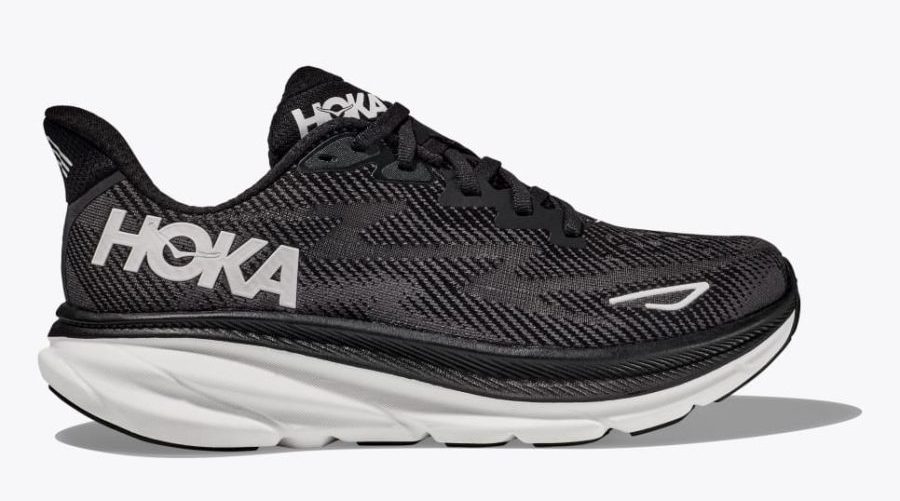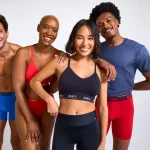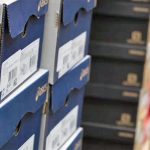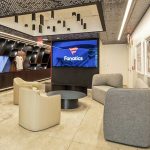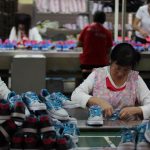Deckers Brands has a long-term strategic vision that remains focused on building Hoka into a multibillion-dollar major player in the performance athletic space, growing the Ugg brand by connecting with consumers through elevated experiences and a segmented product offering, expanding its direct-to-consumer business through consumer acquisition and retention, and driving international growth through strategic investments. The results from the fiscal first quarter ended June 30 go a long way toward most of those goals, perhaps with the exception of the Ugg brand.
“Our ability to propel the targeted opportunities of global Hoka, global DTC, and international Ugg further demonstrates the success of our omnichannel marketplace management and strategic investments,” said company President and CEO Dave Powers when kicking off a conference call with analysts late Thursday. “We will continue to remain nimble in execution, as we always have, to deliver strong results on both the top and bottom line. With the continued execution of our long-term vision, we believe Deckers is emerging as a leading creator of compelling consumer connections through highly desirable products that infuse disruptive innovation across both fashion and performance.”
Powers said that fiscal Q1 results slightly outpaced the company’s expectations, with consolidated revenue increasing 10 percent year-over-year to $676 million, gross margin improving more than 300 basis points, including beneficial brand and channel mix dynamics, and diluted earnings per share growing 45 percent to $2.41 a share.
“Revenue growth versus last year was driven by our key areas of focus, with global Hoka expanding 27 percent to deliver $420 million, global DTC increasing 35 percent to represent 37 percent of portfolio revenue, up from 30 percent last year, and international Ugg delivering strong growth,” Powers detailed on the call. “As anticipated, we had some offsets to the growth in the quarter due to timing dynamics in Ugg U.S. wholesale, with accounts choosing to receive products for it later into the year as opposed to a front-loaded preference we saw in the last couple of years. As we look to best manage our wholesale account product flow, we also continue to monitor marketplace inventory levels to maintain a healthy omnichannel presence that services our end consumer in the best way possible, and preserves the premium nature of our brands.”
Despite the concerns over the delay in Ugg shipments, Powers and the DECK team feel good enough about the year ahead to update their outlook for the full fiscal year, which includes a raise to their prior expectations, with the Hoka direct-to-consumer (DTC) business taking center stage in their growth strategy.
Deckers Brands is increasing its full-year top-line revenue guidance to be approximately $3.98 billion, up slightly from the previous range of approximately $3.95 billion, representing full-year growth expectations of approximately 10 percent versus the prior fiscal year.
The company now expects Hoka’s growth to exceed 20 percent for fiscal year 2024, with the majority of growth anticipated to come from the brand’s DTC business.
Ugg revenue is still expected to increase in low-single-digits for the year, driven by international expansion and a focus on driving more business to DTC.
Company CFO Steve Fasching said on the call that gross margin is still expected to be approximately 52 percent, representing a more than 150 basis point improvement versus last year.
“SG&A is still expected to be approximately 34 percent of revenue, as we re-invest gross margin improvements in key areas of the business,” Fasching said. “Operating margin is still expected to be approximately 18 percent. Our effective tax rate is still projected to be 22 percent to 23 percent, and we are increasing our diluted earnings per share expectation now to be in the range of $21.75 to $22.25.”
Fasching said the 65 cents per share increase in the EPS forecast is related to the increased expectation for Hoka DTC and an increased expectation for interest income as the company benefits from working capital improvements, including inventory management, driving higher cash balances that are earning at a higher interest rate.
To kick off the first quarter and better understand the update to guidance, it is important to understand how important the Hoka DTC business is to the overall plan as it is responsible for the majority of the brand’s growth. The multi-brand strategy for Deckers is on full display as Hoka becomes the focus as Ugg did in years past. Perhaps the biggest upside in this cycle is realizing the bigger year-round opportunity for Hoka versus the company’s efforts in past years to achieve that balance with Ugg.
“Global direct-to-consumer drove first-quarter revenue growth, increasing 35 percent versus the prior year on a reported basis, and 33 percent on a comparable basis,” Powers shared. “Strength in the channel was driven by continued increases in Hoka consumer acquisition and retention globally. Hoka consumer growth was robust across regions and various age demographics, with outsized growth among international markets and the 18- to 34-year-old cohort, which remains key targets for us.”
The Ugg DTC business also experienced growth, reportedly driven by a more than 20 percent increase internationally, and benefitting from China catching up from lockdowns in the prior year. The strength in China reportedly resulted from the increased adoption of both sneaker and sandal styles.
“Wholesale global revenue was down 1 percent in the quarter, as gains in Hoka were offset by Ugg U.S. shipment timing realignment to pre-pandemic cadence, as well as a continued focus to manage the marketplace inventory of the company’s brands to maintain high levels of full-price selling in the more promotional consumer landscape,” Powers detailed.
Global Hoka revenue increased 27 percent to $420 million in the fiscal first quarter, the first time the brand eclipsed $400 million in a single quarter. Powers said the Hoka brand’s well-managed ecosystem of access points continues to flourish. DTC was said to be the primary growth driver in the quarter, increasing 63 percent versus the year-ago quarter, and accounting for approximately two-thirds of total brand growth.
“DTC growth was broad-based as each region grew the business more than 50 percent versus the prior year, global consumer acquisition increased 58 percent, global consumer retention increased 57 percent, and 18- to 34-year-old consumers in the U.S. increased 68 percent,” Powers detailed.
Powers went on to say the strong DTC demand resulted in an improvement in gross margin as Hoka maintained high levels of full-price selling, and continues to benefit from shifting a greater proportion of revenue mix to DTC.
“While the Hoka brand’s DTC business is still predominantly e-commerce, our select retail stores are augmenting the brand’s presence by increasing awareness and brand engagement with a physical presence in key strategic markets, creating personal consumer connections through community-oriented experiences and broadening category adoption by showcasing the depth of the Hoka product offering,” he shared.
Powers said the company expects to continue testing potential permanent locations through pop-up stores.
From a wholesale perspective, Hoka reportedly continues to drive growth and manage the marketplace to build market share in existing points of distribution, maintain high levels of full-price sell-through, increase category shelf space through differentiated products and expand brand awareness with a broader consumer demographic.
“Hoka has preserved high levels of full-price sell-through and remains one of the fastest turning brands within the majority of its wholesale accounts,” Powers said on the call.
He said they continue to tightly manage the marketplace inventory and closely monitor Hoka’s key performance indicators in the channel to ensure the brand maintains its premium positioning across its ecosystem of access points. It appears that the strategy is to convert more consumers to the DTC business by highly managing the inventory available in the wholesale retail marketplace and keeping pricing at preferred levels and limiting promotional activity. That helps margins for both Hoka and the retailer.
“As excess consumer demand materializes, we prefer that Hoka satisfies the upside through the brand’s DTC business, which is what we saw happen this quarter,” Powers explained.
They are also achieving the shift through focused marketing efforts such as the recent Fly Human Fly campaign that drove consumers directly to Hoka.com with the vast majority of digital campaign asset clicks yielding first-time visitors to the brand’s e-commerce platform globally, more than doubling the conversion rate of Hoka.com landing page visitors, and significant impressions from out-of-home activations.
“We are optimistic about the reach and broad appeal of this campaign as Hoka continues to introduce itself to new consumers around the world,” Powers said.
Ugg’s global revenue in the first quarter decreased 6 percent year-over-year to $196 million. The decline was said to be due to lapping earlier wholesale shipping patterns over the last couple of years in the U.S.
“Ugg was able to offset this challenging compare in the U.S. with the strength of the brand’s international regions,” Powers said. “International strength was broad-based across multiple regions, and in both wholesale and DTC channels. In particular, our EMEA region, as well as China, which benefited from lapping lower demand from lockdowns in the prior year, drove above-average growth.”
These regions reportedly found success attracting consumers with more transitional styles, like the Ultra Mini, Tasman, and Classic Mini, as well as seasonal franchises, like the Goldenstar and LA Cloud.
“We are encouraged by the continued progress of international regions to increase the adoption of key global franchises year-round,” Powers said on the call. “Part of the excitement behind these franchises is being driven by the brand’s more focused approach to product marketing, creating greater global alignment of key stories. With this more focused approach, Ugg is maintaining high levels of brand heat with more consumers actively searching for the brand.”
Powers shared that during the first quarter, online search interest for the Ugg brand across Europe increased 60 percent versus last year, with outsized strength in the U.K. and France. The same is true in the U.S., where search interest reportedly increased 21 percent versus last year, according to Google Trends.
“Ugg brand momentum also benefited from this spring’s Feel House activation at Coachella,” Powers said. “The Feel House, first launched in the fall of 2022, is a multi-sensory community experience dedicated to making self-expression comfortable for all. Ugg invited individuals from around the world to experience this latest iteration of the Feel House, which was designed as an oasis for creatives in Palm Springs, CA.”
Powers went on to say that, as a result of the Ugg team’s continued brand activations and compelling products, Ugg global DTC sales increased 6 percent versus last year.
“Ugg experienced consumer demand both in stores and online,” he said. “We have been excited by the interest of consumers who are shopping in person, especially during the spring and summer seasons. We believe this dynamic is partly attributable to the development and greater adoption of transitional franchises that embrace the brand’s heritage DNA and have greater year-round wearing occasions.”
He said that by maintaining this momentum, the entire Ugg product portfolio benefits, especially in its own stores, where, he said, consumers can feel and directly engage with the broader product offering.
“For this reason, and in line with our focus on elevating the Ugg brand in an influential international market, subsequent to quarter-end, we opened our newest flagship store in the high tourist traffic Harajuku shopping district of Tokyo,” Powers concluded.
Teva brand net sales decreased 18.8 percent to $48.4 million in the quarter, compared to $59.6 million in fiscal Q1 last year.
Sanuk brand net sales decreased 32.3 percent to $9.6 million in Q1, compared to $14.2 million in the year-ago period.
Other brands, primarily composed of Koolaburra, net sales decreased 33.9 percent to $1.8 million in Q1, compared to $2.7 million in Q1 last year.
Consolidated company gross margins for the quarter were 51.3 percent of sales, up 330 basis points from last year’s 48.0 percent. First quarter gross margin reportedly benefited from lower freight costs, a greater mix of Hoka brand revenue, and an increased mix of DTC business with slight offsets from unfavorable foreign currency exchange rates compared to the same period last year, and select closeouts of seasonal inventory.
SG&A was $276 million in the first quarter, up 16 percent from last year’s $238 million. SG&A growth was said to be driven by reinvestment in key areas of the business in support of the company’s growth targets, which includes strategic marketing, including the spend intended to amplify Hoka awareness in leading international markets, supply chain footprint to match the growing scale of the organization, enhanced e-commerce capabilities, and talent across the organization, including areas they have delayed in the enterprise support functions, according to a statement from Fasching.
“Our tax rate was 21.9 percent, which compares to 21.3 percent in the prior year,” Fasching said. “These results coupled with higher interest income and a lower share count as a result of our share repurchases program drove diluted earnings per share of $2.41 for the quarter, which was 75 cents above last year’s $1.66 per share, representing growth of 45 percent.”
Deckers Brands ended June with $1.05 billion of cash and equivalents. Inventory was $741 million at quarter-end, down 12 percent versus the same point in time last year, and the company had no outstanding borrowings. During the first quarter, DECK repurchased approximately $25 million worth of shares at an average price of $485.95. As of June 30, the company had approximately $1.3 billion remaining under its stock repurchase authorization.
Photo courtesy Dave Powers/Yahoo

